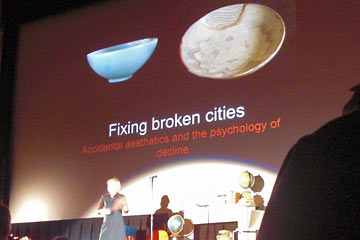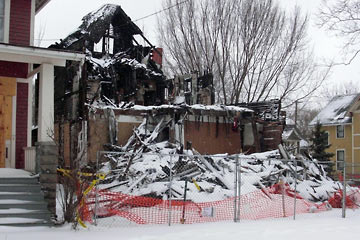FEBRUARY 26, 2010
Great ideas
 Organizers of TEDxCLE, Hallie Bram and Eric Kogelschatz, talk about the day's events from the stage of the Capital Theater.
Organizers of TEDxCLE, Hallie Bram and Eric Kogelschatz, talk about the day's events from the stage of the Capital Theater.
In spite of dire storm warnings and snow that had been falling all day and night, the lobby was packed when I got there.
I got an aisle seat near the front and settled in for our version of the inspirational TED Conference.
Interesting, but...
The first two speakers both talked about new technological developments that have great promise for the city and the world. Dr. C. Martin Harris of the Cleveland Clinic explained a patient-centered web of technology that may change how we provide health care in this country. Good stuff, but almost old news by now. And the Cleveland Clinic-branded Powerpoint slides were uncomfortably close to corporate advertising.
Benson P. Lee of AnywereEnergy showed off a small cabinet-sized fuel cell power generator and nervously read his speech. I can see the promise of this electricity source that can run on virtually any kind of fuel, including natural gas, soybean oil, biodiesel, and ethanol. I don't doubt Mr. Lee's goal of sending units to developing countries where they can bring people out of poverty and (literally) darkness. I truly hope his company succeeds famously. But his speech too had the feel of a sales pitch.
I was getting a bit restless. The great TED videos I've watched have shown inspired people giving inspirational talks. Wasn't happening here.
Inspiration
 Inspiration took the stage in the form of Terry Schwartz, senior planner with Kent State's Cleveland Urban Design Collaborative.
Inspiration took the stage in the form of Terry Schwartz, senior planner with Kent State's Cleveland Urban Design Collaborative.
She talked about disasters like Hurricane Katrina and the Japanese tradition of kintsugi in which broken bowls are repaired to look better than the original.
She tossed out the idea of accidental aesthetics and suggested we create meaning from loss rather than trying to make it look like nothing happened.
The loss might be due to natural causes (Katrina, Haiti) or social/economic upheavals, the ones that have left Rustbelt cities like Cleveland and Detroit struggling to re-invent themselves. Her solution: repair the damage while embracing it. She's even started the Shrinking Cities Institute to explore how planned shrinkage can be better than continuous growth.
One idea that really hit home showed a street corner in Glenville, formerly a gas station, where a temporary park could make the land a community asset until something permanent was built there. The sketches showed a repair that didn't hide the damage but made it into something beautiful.
 Later, as I headed down 32nd Street towards home I thought how this could be a way to reclaim the scarred site where the boarding house burned a few months ago.
Later, as I headed down 32nd Street towards home I thought how this could be a way to reclaim the scarred site where the boarding house burned a few months ago.
Today a charred skeleton remains, marked off with crime scene tape and a homemade memorial to the four people who died that night.
Eventually the city will demolish what's left. Maybe we can bring neighbors together to make a beautiful memorial until someone builds again on that lot.
Inspiration, for sure. Thanks, Terry.
More
TEDxCLE, Pt. 2 — February 27, 2010
Top |
|
![]()
